check engine light Alfa Romeo 166 2007 Owner handbook (in English)
[x] Cancel search | Manufacturer: ALFA ROMEO, Model Year: 2007, Model line: 166, Model: Alfa Romeo 166 2007Pages: 272, PDF Size: 4.17 MB
Page 80 of 272
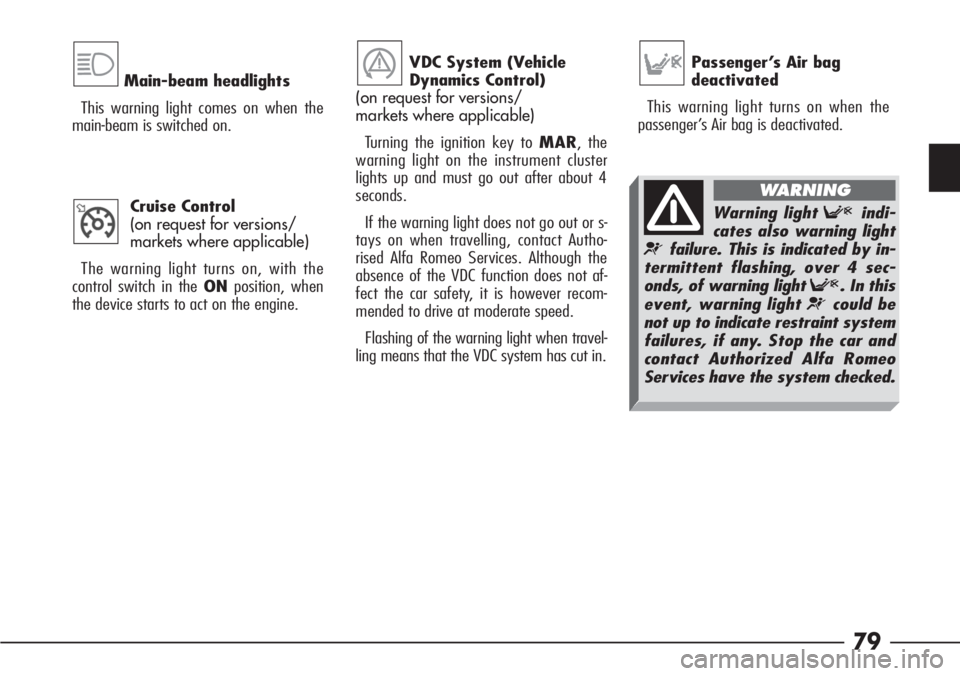
79
Main-beam headlights
This warning light comes on when the
main-beam is switched on.
Cruise Control
(on request for versions/
markets where applicable)
The warning light turns on, with the
control switch in the ONposition, when
the device starts to act on the engine.
1VDC System (Vehicle
Dynamics Control)
(on request for versions/
markets where applicable)
Turning the ignition key to MAR, the
warning light on the instrument cluster
lights up and must go out after about 4
seconds.
If the warning light does not go out or s-
tays on when travelling, contact Autho-
rised Alfa Romeo Services. Although the
absence of the VDC function does not af-
fect the car safety, it is however recom-
mended to drive at moderate speed.
Flashing of the warning light when travel-
ling means that the VDC system has cut in.
áPassenger’s Air bag
deactivated
This warning light turns on when the
passenger’s Air bag is deactivated.
Warning light Findi-
cates also warning light
¬failure. This is indicated by in-
termittent flashing, over 4 sec-
onds, of warning light F. In this
event, warning light ¬could be
not up to indicate restraint system
failures, if any. Stop the car and
contact Authorized Alfa Romeo
Services have the system checked.
WARNING
Page 111 of 272
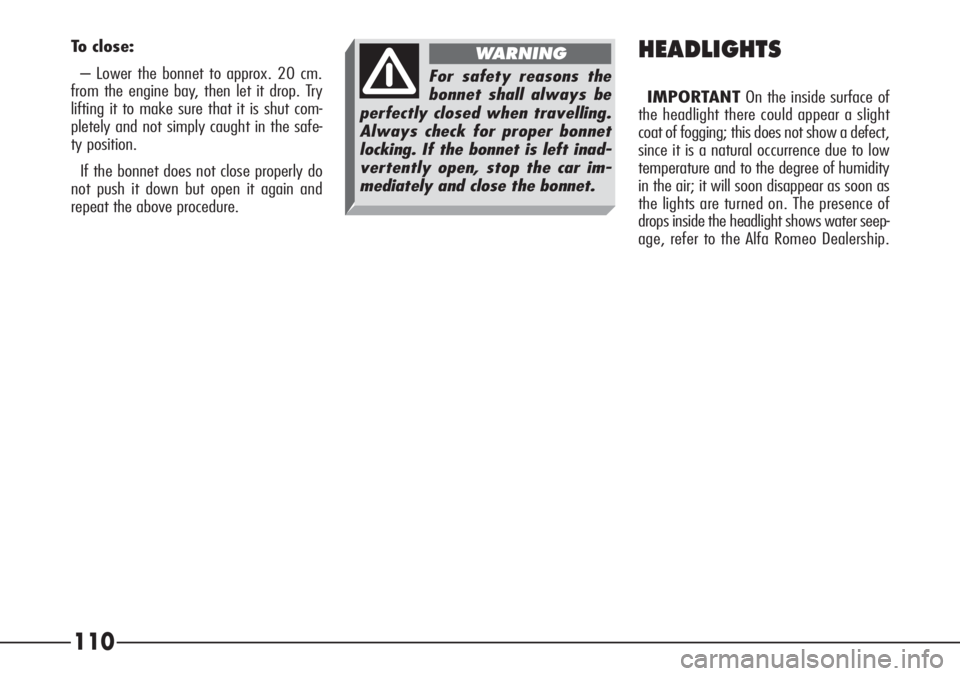
110
To close:
– Lower the bonnet to approx. 20 cm.
from the engine bay, then let it drop. Try
lifting it to make sure that it is shut com-
pletely and not simply caught in the safe-
ty position.
If the bonnet does not close properly do
not push it down but open it again and
repeat the above procedure.HEADLIGHTS
IMPORTANTOn the inside surface of
the headlight there could appear a slight
coat of fogging; this does not show a defect,
since it is a natural occurrence due to low
temperature and to the degree of humidity
in the air; it will soon disappear as soon as
the lights are turned on. The presence of
drops inside the headlight shows water seep-
age, refer to the Alfa Romeo Dealership.
For safety reasons the
bonnet shall always be
perfectly closed when travelling.
Always check for proper bonnet
locking. If the bonnet is left inad-
vertently open, stop the car im-
mediately and close the bonnet.
WARNING
Page 114 of 272

113
EOBD SYSTEM
(optional for versions/
markets where applicable
)
The EOBD system (European On Board
Diagnosis) allows continuous diagnosis of
the components of the car correlated with
emissions.
This system continuously monitors the
components of the vehicle related to e-
missions; it also indicates, when the
Uwarning light comes on on the instrument
panel, that the components in question
are in poor condition.
IMPORTANTAfter the problem has
been resolved, to completely check the
system, the Alfa Romeo Authorized Ser-
vice Station must carry out tests on a test
bench and, if necessary, road tests that
could be long.If, when the ignition key
is turned to MAR, the
Uwarning light does
not come on or if, when driving, it
lights up and emits a fixed light
or a flashing one, contact an Alfa
Romeo Authorized Service Station
as soon as possible. Warning
light
Uoperation can be checked
by means of special equipment
by traffic agents. Always comply
with the traffic regulations in
force in the country where you
are travelling.
The objective is the following:
– to keep under control the efficiency of
the system;
– to warn when a fault causes emission
levels to increase;
– to indicate the need to replace the
deteriorated components.
The system also has a diagnostic con-
nector that can be interfaced with appro-
priate tools, which makes it possible to
read the error codes stored in the control
unit, together with a series of specific pa-
rameters for engine operation and diag-
nosis. This check can also be carried out
by the traffic police.
Page 116 of 272
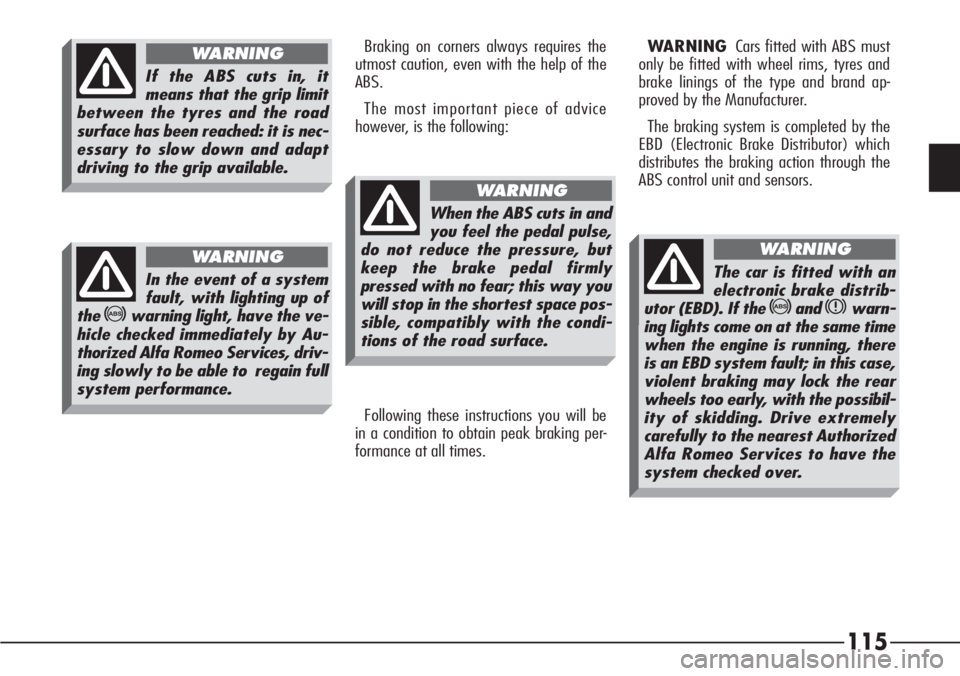
115
Braking on corners always requires the
utmost caution, even with the help of the
ABS.
The most important piece of advice
however, is the following:WARNINGCars fitted with ABS must
only be fitted with wheel rims, tyres and
brake linings of the type and brand ap-
proved by the Manufacturer.
The braking system is completed by the
EBD (Electronic Brake Distributor) which
distributes the braking action through the
ABS control unit and sensors.
Following these instructions you will be
in a condition to obtain peak braking per-
formance at all times.
If the ABS cuts in, it
means that the grip limit
between the tyres and the road
surface has been reached: it is nec-
essary to slow down and adapt
driving to the grip available.
WARNING
In the event of a system
fault, with lighting up of
the
>warning light, have the ve-
hicle checked immediately by Au-
thorized Alfa Romeo Services, driv-
ing slowly to be able to regain full
system performance.
WARNING
When the ABS cuts in and
you feel the pedal pulse,
do not reduce the pressure, but
keep the brake pedal firmly
pressed with no fear; this way you
will stop in the shortest space pos-
sible, compatibly with the condi-
tions of the road surface.
WARNING
The car is fitted with an
electronic brake distrib-
utor (EBD). If the
>andxwarn-
ing lights come on at the same time
when the engine is running, there
is an EBD system fault; in this case,
violent braking may lock the rear
wheels too early, with the possibil-
ity of skidding. Drive extremely
carefully to the nearest Authorized
Alfa Romeo Services to have the
system checked over.
WARNING
Page 117 of 272
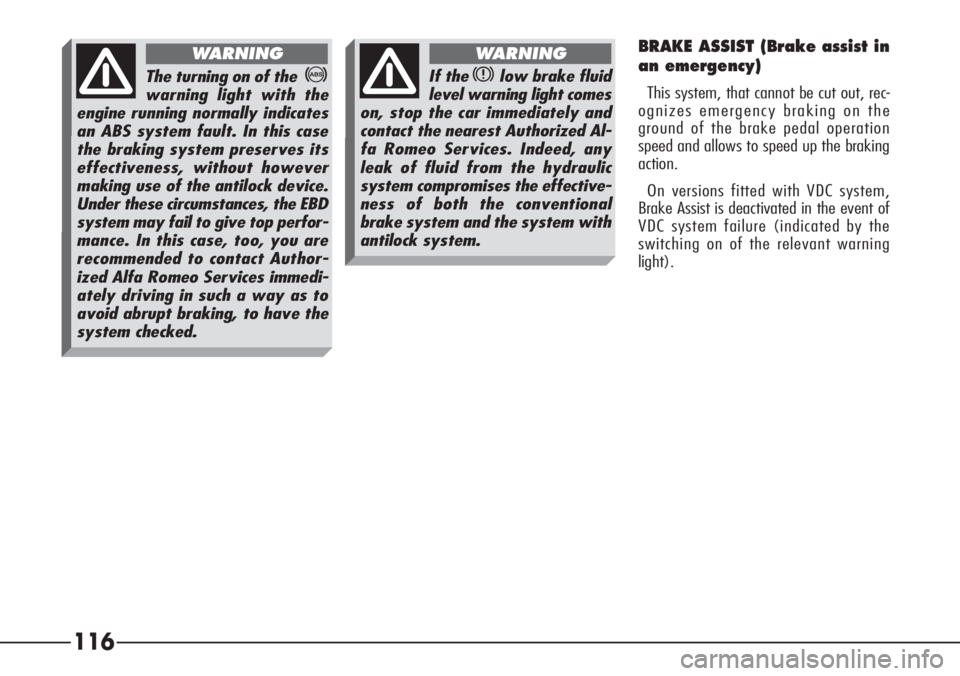
116
BRAKE ASSIST (Brake assist in
an emergency)
This system, that cannot be cut out, rec-
ognizes emergency braking on the
ground of the brake pedal operation
speed and allows to speed up the braking
action.
On versions fitted with VDC system,
Brake Assist is deactivated in the event of
VDC system failure (indicated by the
switching on of the relevant warning
light).
The turning on of the>
warning light with the
engine running normally indicates
an ABS system fault. In this case
the braking system preserves its
effectiveness, without however
making use of the antilock device.
Under these circumstances, the EBD
system may fail to give top perfor-
mance. In this case, too, you are
recommended to contact Author-
ized Alfa Romeo Services immedi-
ately driving in such a way as to
avoid abrupt braking, to have the
system checked.
WARNING
If the xlow brake fluid
level warning light comes
on, stop the car immediately and
contact the nearest Authorized Al-
fa Romeo Services. Indeed, any
leak of fluid from the hydraulic
system compromises the effective-
ness of both the conventional
brake system and the system with
antilock system.
WARNING
Page 122 of 272
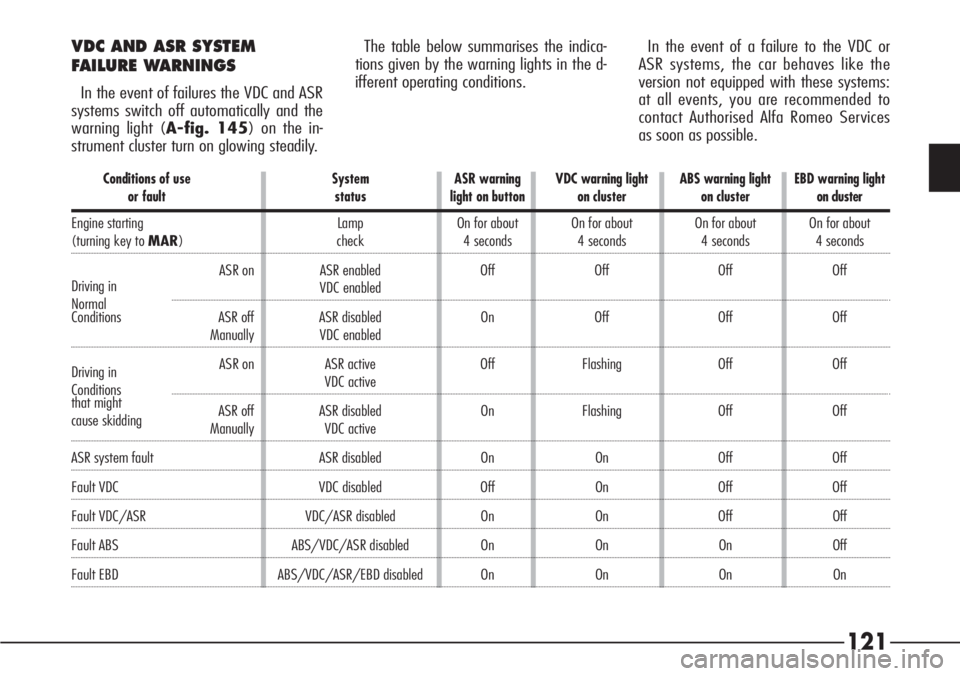
121
VDC AND ASR SYSTEM
FAILURE WARNINGS
In the event of failures the VDC and ASR
systems switch off automatically and the
warning light (A-fig. 145) on the in-
strument cluster turn on glowing steadily.The table below summarises the indica-
tions given by the warning lights in the d-
ifferent operating conditions.In the event of a failure to the VDC or
ASR systems, the car behaves like the
version not equipped with these systems:
at all events, you are recommended to
contact Authorised Alfa Romeo Services
as soon as possible.
Conditions of use System ASR warning VDC warning light ABS warning light EBD warning light
or fault status light on button on cluster on cluster on cluster
Engine starting Lamp On for about On for about On for about On for about
(turning key to MAR) check 4 seconds 4 seconds 4 seconds 4 seconds
Driving inASR on ASR enabled Off Off Off Off
NormalVDC enabled
Conditions ASR off ASR disabled On Off Off Off
Manually VDC enabled
Driving inASR on ASR active Off Flashing Off Off
ConditionsVDC active
that might
ASR off ASR disabled On Flashing Off Off
cause skidding
Manually VDC active
ASR system fault ASR disabled On On Off Off
Fault VDC VDC disabled Off On Off Off
Fault VDC/ASR VDC/ASR disabled On On Off Off
Fault ABS ABS/VDC/ASR disabled On On On Off
Fault EBD ABS/VDC/ASR/EBD disabled On On On On
Page 140 of 272
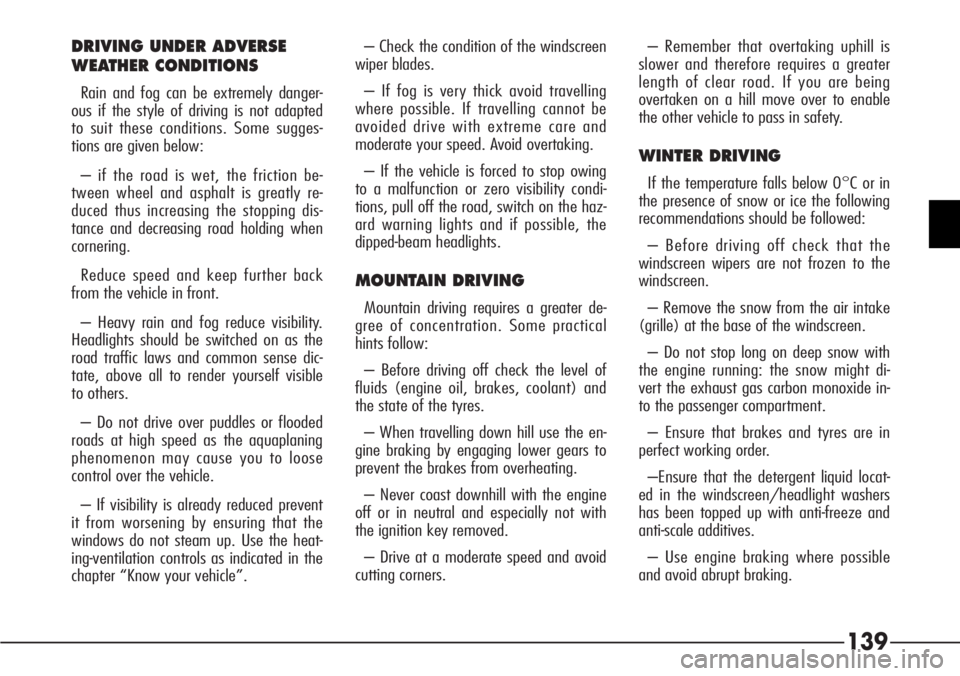
139
DRIVING UNDER ADVERSE
WEATHER CONDITIONS
Rain and fog can be extremely danger-
ous if the style of driving is not adapted
to suit these conditions. Some sugges-
tions are given below:
– if the road is wet, the friction be-
tween wheel and asphalt is greatly re-
duced thus increasing the stopping dis-
tance and decreasing road holding when
cornering.
Reduce speed and keep further back
from the vehicle in front.
– Heavy rain and fog reduce visibility.
Headlights should be switched on as the
road traffic laws and common sense dic-
tate, above all to render yourself visible
to others.
– Do not drive over puddles or flooded
roads at high speed as the aquaplaning
phenomenon may cause you to loose
control over the vehicle.
– If visibility is already reduced prevent
it from worsening by ensuring that the
windows do not steam up. Use the heat-
ing-ventilation controls as indicated in the
chapter “Know your vehicle”.– Check the condition of the windscreen
wiper blades.
– If fog is very thick avoid travelling
where possible. If travelling cannot be
avoided drive with extreme care and
moderate your speed. Avoid overtaking.
– If the vehicle is forced to stop owing
to a malfunction or zero visibility condi-
tions, pull off the road, switch on the haz-
ard warning lights and if possible, the
dipped-beam headlights.
MOUNTAIN DRIVING
Mountain driving requires a greater de-
gree of concentration. Some practical
hints follow:
– Before driving off check the level of
fluids (engine oil, brakes, coolant) and
the state of the tyres.
– When travelling down hill use the en-
gine braking by engaging lower gears to
prevent the brakes from overheating.
– Never coast downhill with the engine
off or in neutral and especially not with
the ignition key removed.
– Drive at a moderate speed and avoid
cutting corners.– Remember that overtaking uphill is
slower and therefore requires a greater
length of clear road. If you are being
overtaken on a hill move over to enable
the other vehicle to pass in safety.
WINTER DRIVING
If the temperature falls below 0°C or in
the presence of snow or ice the following
recommendations should be followed:
– Before driving off check that the
windscreen wipers are not frozen to the
windscreen.
– Remove the snow from the air intake
(grille) at the base of the windscreen.
– Do not stop long on deep snow with
the engine running: the snow might di-
vert the exhaust gas carbon monoxide in-
to the passenger compartment.
– Ensure that brakes and tyres are in
perfect working order.
–Ensure that the detergent liquid locat-
ed in the windscreen/headlight washers
has been topped up with anti-freeze and
anti-scale additives.
– Use engine braking where possible
and avoid abrupt braking.
Page 141 of 272
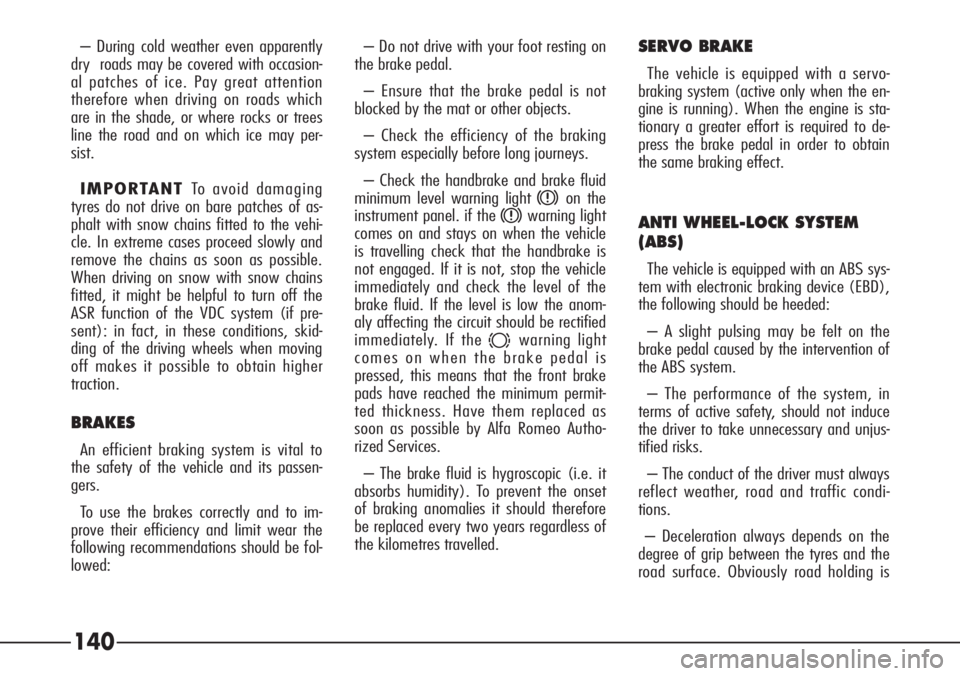
140
– During cold weather even apparently
dry roads may be covered with occasion-
al patches of ice. Pay great attention
therefore when driving on roads which
are in the shade, or where rocks or trees
line the road and on which ice may per-
sist.
IMPORTANT To avoid damaging
tyres do not drive on bare patches of as-
phalt with snow chains fitted to the vehi-
cle. In extreme cases proceed slowly and
remove the chains as soon as possible.
When driving on snow with snow chains
fitted, it might be helpful to turn off the
ASR function of the VDC system (if pre-
sent): in fact, in these conditions, skid-
ding of the driving wheels when moving
off makes it possible to obtain higher
traction.
BRAKES
An efficient braking system is vital to
the safety of the vehicle and its passen-
gers.
To use the brakes correctly and to im-
prove their efficiency and limit wear the
following recommendations should be fol-
lowed:– Do not drive with your foot resting on
the brake pedal.
– Ensure that the brake pedal is not
blocked by the mat or other objects.
– Check the efficiency of the braking
system especially before long journeys.
– Check the handbrake and brake fluid
minimum level warning light
xon the
instrument panel. if the
xwarning light
comes on and stays on when the vehicle
is travelling check that the handbrake is
not engaged. If it is not, stop the vehicle
immediately and check the level of the
brake fluid. If the level is low the anom-
aly affecting the circuit should be rectified
immediately. If the
dwarning light
comes on when the brake pedal is
pressed, this means that the front brake
pads have reached the minimum permit-
ted thickness. Have them replaced as
soon as possible by Alfa Romeo Autho-
rized Services.
– The brake fluid is hygroscopic (i.e. it
absorbs humidity). To prevent the onset
of braking anomalies it should therefore
be replaced every two years regardless of
the kilometres travelled.
SERVO BRAKE
The vehicle is equipped with a servo-
braking system (active only when the en-
gine is running). When the engine is sta-
tionary a greater effort is required to de-
press the brake pedal in order to obtain
the same braking effect.
ANTI WHEEL-LOCK SYSTEM
(ABS)
The vehicle is equipped with an ABS sys-
tem with electronic braking device (EBD),
the following should be heeded:
– A slight pulsing may be felt on the
brake pedal caused by the intervention of
the ABS system.
– The performance of the system, in
terms of active safety, should not induce
the driver to take unnecessary and unjus-
tified risks.
– The conduct of the driver must always
reflect weather, road and traffic condi-
tions.
– Deceleration always depends on the
degree of grip between the tyres and the
road surface. Obviously road holding is
Page 142 of 272
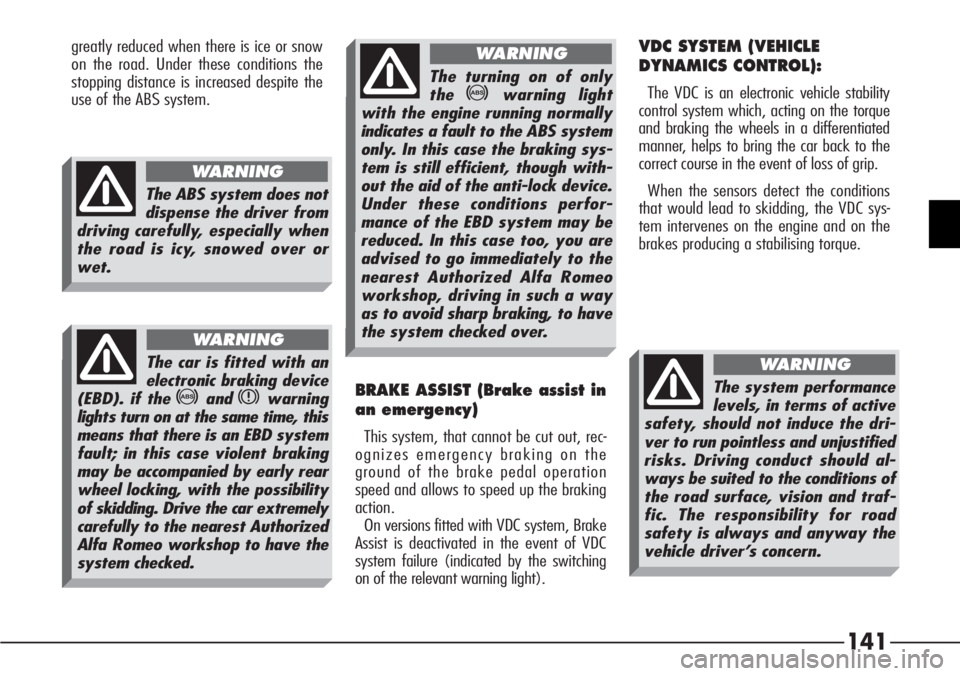
141
greatly reduced when there is ice or snow
on the road. Under these conditions the
stopping distance is increased despite the
use of the ABS system.VDC SYSTEM (VEHICLE
DYNAMICS CONTROL):
The VDC is an electronic vehicle stability
control system which, acting on the torque
and braking the wheels in a differentiated
manner, helps to bring the car back to the
correct course in the event of loss of grip.
When the sensors detect the conditions
that would lead to skidding, the VDC sys-
tem intervenes on the engine and on the
brakes producing a stabilising torque.
BRAKE ASSIST (Brake assist in
an emergency)
This system, that cannot be cut out, rec-
ognizes emergency braking on the
ground of the brake pedal operation
speed and allows to speed up the braking
action.
On versions fitted with VDC system, Brake
Assist is deactivated in the event of VDC
system failure (indicated by the switching
on of the relevant warning light).
The ABS system does not
dispense the driver from
driving carefully, especially when
the road is icy, snowed over or
wet.
WARNING
The car is fitted with an
electronic braking device
(EBD). if the
>andxwarning
lights turn on at the same time, this
means that there is an EBD system
fault; in this case violent braking
may be accompanied by early rear
wheel locking, with the possibility
of skidding. Drive the car extremely
carefully to the nearest Authorized
Alfa Romeo workshop to have the
system checked.
WARNING
The turning on of only
the
>warning light
with the engine running normally
indicates a fault to the ABS system
only. In this case the braking sys-
tem is still efficient, though with-
out the aid of the anti-lock device.
Under these conditions perfor-
mance of the EBD system may be
reduced. In this case too, you are
advised to go immediately to the
nearest Authorized Alfa Romeo
workshop, driving in such a way
as to avoid sharp braking, to have
the system checked over.
WARNING
The system performance
levels, in terms of active
safety, should not induce the dri-
ver to run pointless and unjustified
risks. Driving conduct should al-
ways be suited to the conditions of
the road surface, vision and traf-
fic. The responsibility for road
safety is always and anyway the
vehicle driver’s concern.
WARNING
Page 156 of 272
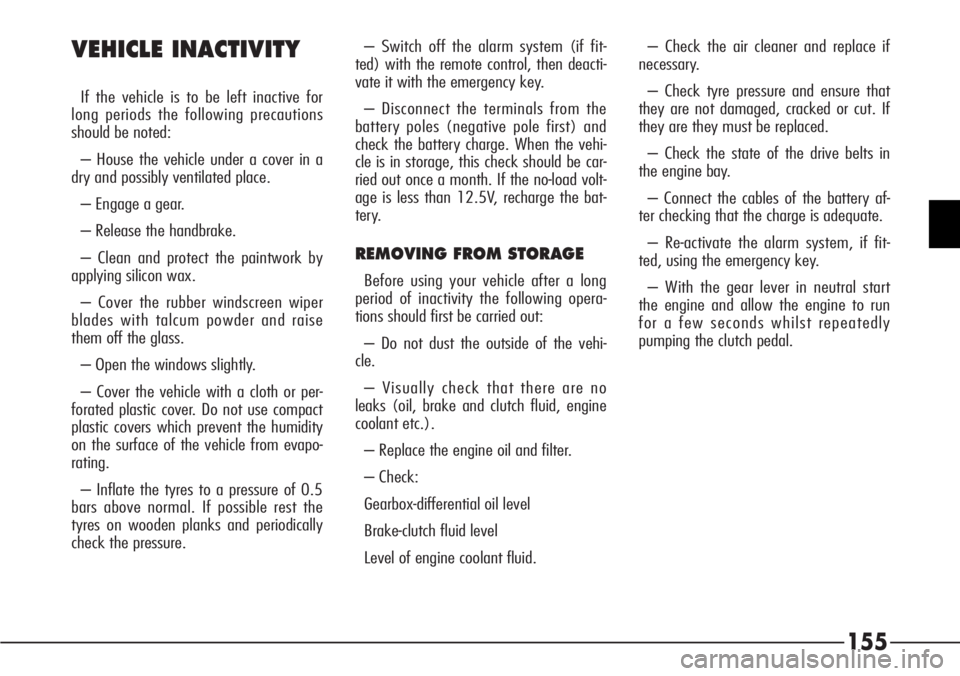
155 VEHICLE INACTIVITY
If the vehicle is to be left inactive for
long periods the following precautions
should be noted:
– House the vehicle under a cover in a
dry and possibly ventilated place.
– Engage a gear.
– Release the handbrake.
– Clean and protect the paintwork by
applying silicon wax.
– Cover the rubber windscreen wiper
blades with talcum powder and raise
them off the glass.
– Open the windows slightly.
– Cover the vehicle with a cloth or per-
forated plastic cover. Do not use compact
plastic covers which prevent the humidity
on the surface of the vehicle from evapo-
rating.
– Inflate the tyres to a pressure of 0.5
bars above normal. If possible rest the
tyres on wooden planks and periodically
check the pressure.– Switch off the alarm system (if fit-
ted) with the remote control, then deacti-
vate it with the emergency key.
– Disconnect the terminals from the
battery poles (negative pole first) and
check the battery charge. When the vehi-
cle is in storage, this check should be car-
ried out once a month. If the no-load volt-
age is less than 12.5V, recharge the bat-
tery.
REMOVING FROM STORAGE
Before using your vehicle after a long
period of inactivity the following opera-
tions should first be carried out:
– Do not dust the outside of the vehi-
cle.
– Visually check that there are no
leaks (oil, brake and clutch fluid, engine
coolant etc.).
– Replace the engine oil and filter.
– Check:
Gearbox-differential oil level
Brake-clutch fluid level
Level of engine coolant fluid.– Check the air cleaner and replace if
necessary.
– Check tyre pressure and ensure that
they are not damaged, cracked or cut. If
they are they must be replaced.
– Check the state of the drive belts in
the engine bay.
– Connect the cables of the battery af-
ter checking that the charge is adequate.
– Re-activate the alarm system, if fit-
ted, using the emergency key.
– With the gear lever in neutral start
the engine and allow the engine to run
for a few seconds whilst repeatedly
pumping the clutch pedal.